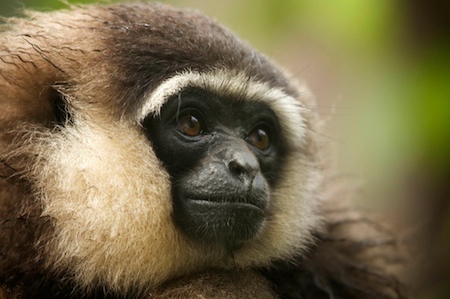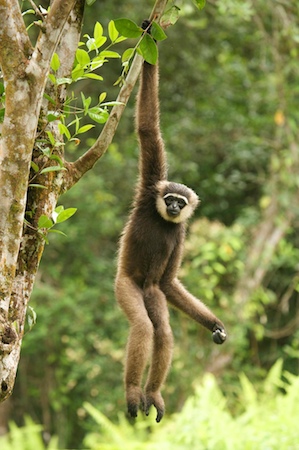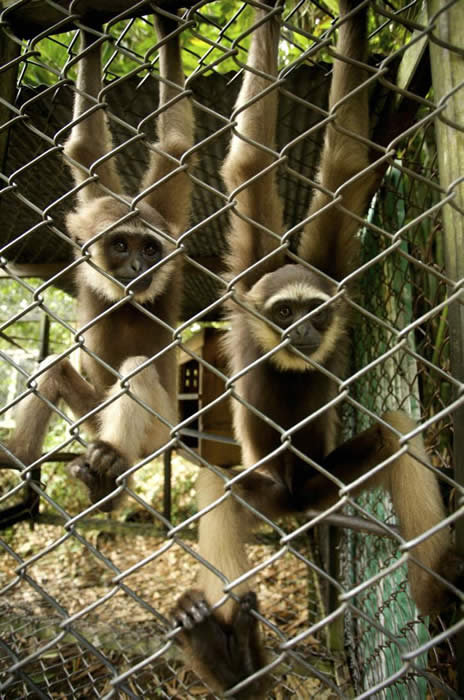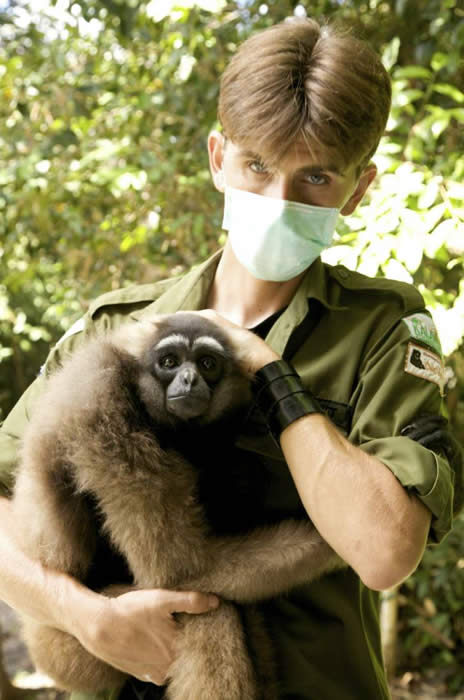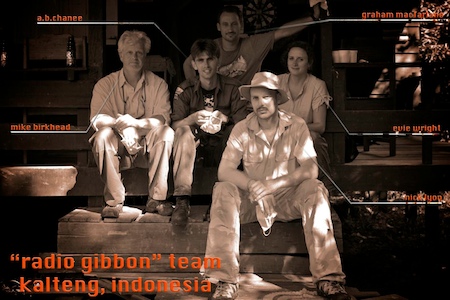

Our Programmes |
Radio Gibbon Premiere BBC2 December 10th Thursday 9pm
RADIO GIBBONNarrated by Adrian Edmondson
A film by Mike Birkhead Associates, for the BBC2 series NATURAL WORLD, about the man behind Borneo’s favourite radio station and how it is helping to rescue, pair up and rehabilitate the singing stars of the primate family: gibbons.
1st transmission: 9pm, Thursday 10 December 2009, BBC2
PROGRAMME SUMMARY
The French are famed for their flair with l’amour but even French stars like Brigitte Bardot and Muriel Robin are impressed by ‘Chanee’ Brulé. Studies he began in boyhood have made him a world expert at match-making for gibbons – the only apes to mate faithfully for life and which can’t survive in the wild without a partner. Now, at a sanctuary in Borneo, Chanee, 29, is using his skills to pair up rescued gibbons, in preparation for their re-release to the forest. Many of the gibbons are found after tip-offs from listeners to the music radio station Chanee also runs and where, as a DJ, he uses breaks between song-plays to air conservation messages on behalf of the ‘singing’ ape.
THE STORY TOLD IN THE FILM
Gibbons are the songsters of the ape family. Unlike any of their cousins, they take only one mate, remain faithful for life, and serenade their partners daily with complex melodies which reaffirm their bonds.
Now, songs of a different tune are helping to safeguard the ‘singing’ apes of Borneo from threats which include deforestation, fuelled by the palm oil industry, and a disregard, even by policemen, of laws against keeping gibbons as pets.
There, a new radio station is using the breaks between beats by artists like Groove Armada, Kid Loco, Massive Attack, M.I.A and the Thievery Corporation to urge young listeners to support the gibbon rescue and rehabilitation work of its top DJ.
Radio Kalaweit is run by ‘Chanee’ Brulé, a 29-year-old Frenchman who fell in love with gibbons after seeing them in a zoo as a child and then spent so much time studying them that, at aged 13, he wrote such a well-informed guide to their care in captivity that it is still used today.
The book and its publicity won Chanee enough funding, first, to look at gibbons in the wild and then, with donations from film stars Brigitte Bardot and Muriel Robin, to create a sanctuary for them in a region of Borneo called Kalimantan.
Today, the sanctuary is mostly populated with gibbons (‘kalaweit’ in the local language) rescued after tip-offs to the radio station, which commands big audiences, especially among the under 30s. Before any of the animals can be returned to the wild, however, each needs to be matched with a mate or it will be attacked, and sometimes killed, by other couples defending their territory. So, the sanctuary doubles as a gibbon dating agency, with Chanee as its world class match-maker.
He says: It’s not like chicken. You can’t put one male and one female in one cage and for sure it will be a good pair. You need to find the right character, the right gibbon with the right partner. We never know if it will work, but what we can anticipate is who will be the boss in the enclosure. In every pair we have one dominant, sometimes it’s the female, sometimes it’s a male. If both gibbons don’t want to be dominated they will fight until one die.”
The film follows Chanee as he delivers conservation messages via Radio Kalaweit, follows up on leads from listeners, leads his team on gibbon rescue missions, welcomes new arrivals and arranges blind dates for sanctuary residents, Leoni and Bundad and Holly and Habir.
Along the way, viewers will meet some of the sanctuary’s other residents, including Graham, a rhinoceros hornbill re-learning how to fly, and journey to Kalaweit’s latest sanctuary: Marak, an island off the west coast of Sumatra. There, the audience will witness a sequence never shown on UK tv before – a family of gibbons called siamangs leaving captivity to live wild and free once more.
Radio Gibbon is a Mike Birkhead Associates production for the BBC Natural History Unit series, Natural World. It gets its first UK transmission on Thursday 10 December (Xpm, BBC2). The series editor is Tim Martin.
- ends -
Media queries For more info, preview tapes, stills or interviews, please contact Pam Beddard 0117 987 0442/ 07767 621207
QUOTES FROM THE FILM (all spoken by Chanee Brulé)
On how he became so involved with gibbons: “It was just interest at the beginning - why they are so different? Why it is so difficult to take care of them? Why do so many of them die in captivity? And with time I start to understand them and that’s when I start to love gibbons and be specialised in gibbon. I like to say I speak gibbon.”
On mixing music and conservation: “People like [Radio] Kalaweit because it’s cool. There’s a lot of modern music; it’s a very modern image, and the young love that. We have to give them what they want, but between every two or three songs we have this short message about conservation. So it’s working very well. I’m very happy. And it’s nice also to save animals with good music.”
On Radio Kalaweit’s impact in the Kalimantan region: “Now after 5 years we don’t have any animal market any more in public places…..just because of the simple fact that if someone try to sell a gibbon in the market…. in the next 30 minutes we will receive a call here telling us of the situation. Sometimes people just come and give us animals.”
After meeting the owner of a pet gibbon: “He was very surprised when I try to explain to him that a gibbon lives 30 years in the wild, and he was like: ‘Whoa, I was thinking they just live around five or seven years, because I have gibbon before and they always die before seven’.”
On the impact of his work as a DJ, conservationist and gibbon match-maker: “Kalaweit is too small to pretend we can save the gibbon. Kalaweit can’t save the gibbon. We can save some individual and it’s what we are doing. We have to do it, and I’m happy to do it and I give a second chance for some animal - even for the animal who will never come back into the wild: the 25% gibbon infected by human disease. They have a decent life. They have a gibbon life at least. They are not alone, they have a partner, and it’s what I’m doing, I just try to make the situation better for them.”
GIBBON FACT FILE
Gibbons belong to the family of lesser apes called Hylobatidae which means tree-dwelling. They live in tropical and sub-tropical forest in and around India and China, including the islands of Borneo, Java and Sumatra. The family contains many different species which vary in size, appearance and behaviour. A shared characteristic, though, is that unlike their larger wild cousins – bonobos, chimpanzee, gorillas and orang-utans – gibbons stay with the same partner for life and use complex and melodious songs to re-affirm the pair bond and defend their territory. They are also the fastest and most agile of all the apes – swinging distances of up to 15 metres (50 feet) between branches and at speeds which can reach 56km/h (35mph). This combination of musicianship and agility has led to gibbons being nicknamed ‘the swinging singing apes’.
PALM OIL: THREAT TO GIBBONS
A major threat to gibbons, and many other species, is deforestation and habitat loss resulting largely from the booming world market for palm oil – an ingredient now used in many everyday foods, from chocolate bars to oven chips; in cosmetics and as a biofuel. To keep up with demand, many countries are clearing forests and peatlands to make way for palm oil plantations. In Indonesia alone, such plantations already cover 6m hectares and there are plans to almost double the acreage by 2015. The spread is causing great concern among environmental watchdogs and not just because logging and deforestation severely damage biodiversity. It is also feared the expansions will damage Earth’s carbon storage systems and that an over-reliance on a single crop will mean disaster if the crop fails.
The Production Team.
|

